

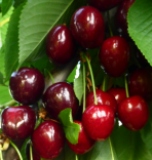 As the UK Cherry harvest gets seriously under way - The English Apple Man visits East Kent
As the UK Cherry harvest gets seriously under way - The English Apple Man visits East Kent
On Tuesday evening members of East Kent Fruit Society (EKFS) met at Will & David Riccini's Bekesbourne Farm, near Canterbury in East Kent. The brothers farm three sites near Canterbury - Bekesebourne, Stourmouth and Staple.
W&D Riccini was formed 15 years ago. Since then the partnership has grown from 40 acres to nearly 140 acres producing nearly 4500 bins of top fruit, hopefully peaking to 5000 in 2017. The majority of the apple yield comes from 2 varieties; Gala and Braeburn.
Will and David started growing cherries under redundant soft fruit tunnels 8 years ago and currently have 15 acres in the ground with 7 acres under production. There are about 12 acres on (Gisella) G3 rootstock and 3 acres on G5.
This year they anticipate picking circa 15 tonnes/hectare on the more mature orchards from Penny, Regina, Karina and Kordia.
Collectively the farms cover 140 acres; 42 acres at Bekesbourne; 78 acres at Stourmouth and 20 acres at Staple.
Below: The tunnels housing the older trees now in full production
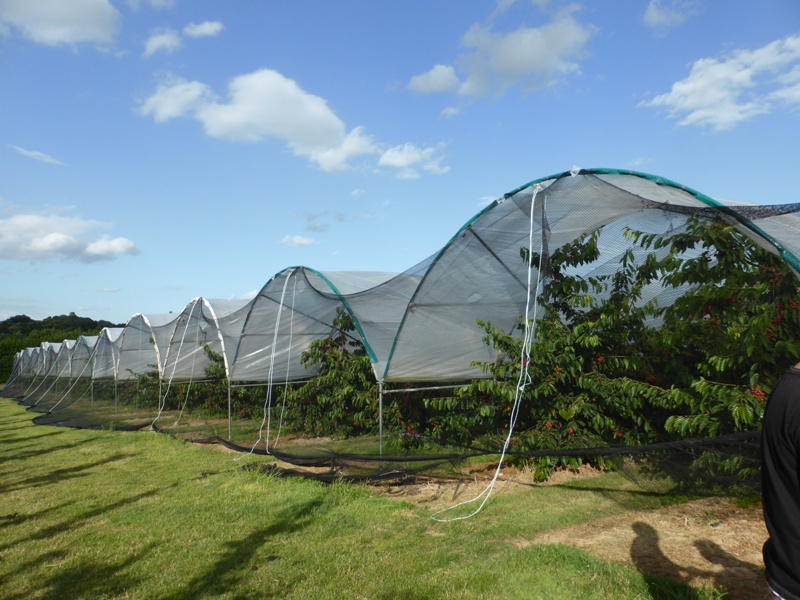
The first cherries on the 'tour' were 3 year old trees; the Riccini brothers have experimented with 'twisting' the leader around the tree stake in an attempt to produce better initiation of young side branches which will become the growing platform for the crop. Will said; looking back he is not sure if the twisting is a benefit or not?
For an insight into the 'twisting' philosophy, take a look back to a visit in 2013 - Click on Journal for 24 May 2013
Below: Will Riccini explaining the reason for 'twisting the leader' around the tree stake
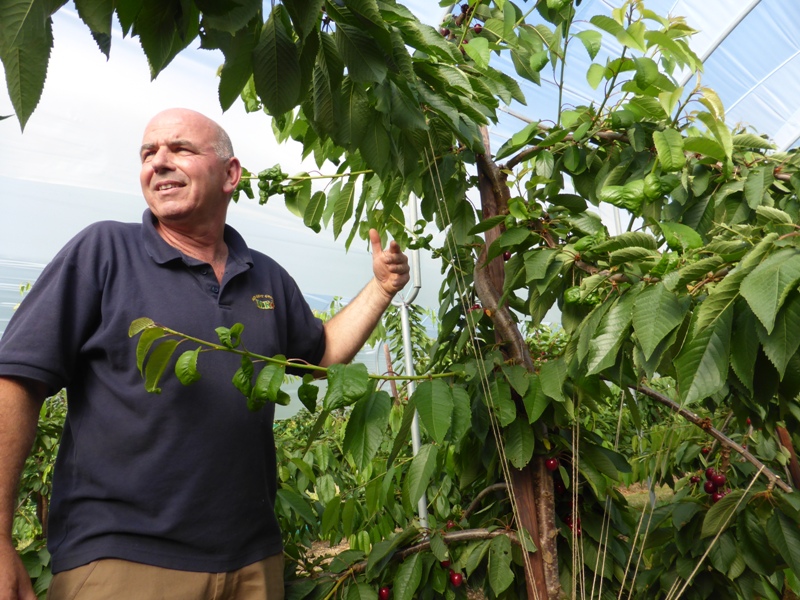
Below: EKFS members tour the cherry tunnels at Bekesbourne
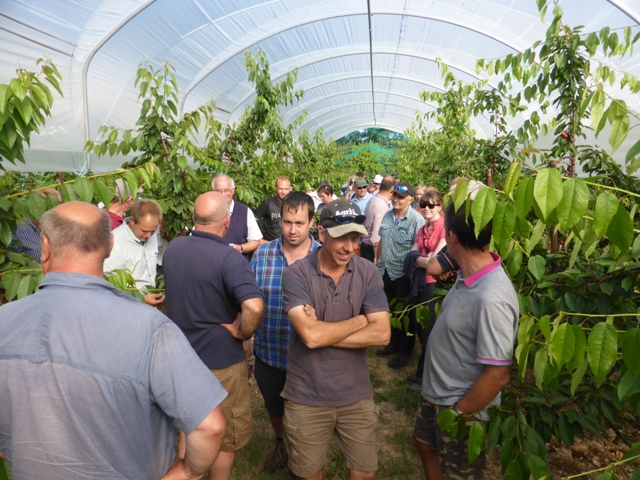
Another interesting point raised during the tour of the cherry tunnels, was the procedure for replacing older branches; the standard advice is to cut back the branch leaving a stub (e.g. 2-3 inches in length on which new shoots will form. Will and David are now following advice from fruit advisor Leon Jahae to cut back to the growth ring. Leon believes this gives a better opportunity for 'new branch' material.
Below: a close up of the twisted leader and a young tree with good quality, well spaced young branches
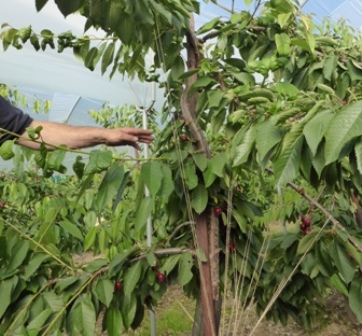
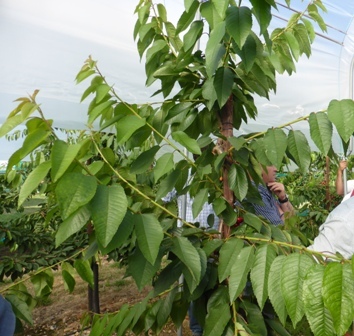
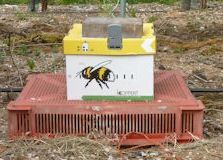 As we walked through the more mature tunnels, with seemingly no room for any more branches per tree and any more cherries per branch, the speculation on what the yield might be, ranged from 15 - 20 tonnes per hectare. The tree height, due to the tunnel height is not as high as can be found on cherry farms with higher tunnels, so it may end up at 15 tonnes - 'still a very good' yield.
As we walked through the more mature tunnels, with seemingly no room for any more branches per tree and any more cherries per branch, the speculation on what the yield might be, ranged from 15 - 20 tonnes per hectare. The tree height, due to the tunnel height is not as high as can be found on cherry farms with higher tunnels, so it may end up at 15 tonnes - 'still a very good' yield.
To achieve the full yield potential, pollination is paramount and the Riccini brothers have supplemented the bumble bees with 6-8 hives of honey bees.
Below: the cropping branches are under control and carrying a heavy crop - in the second picture an example of a branch loaded with fruit
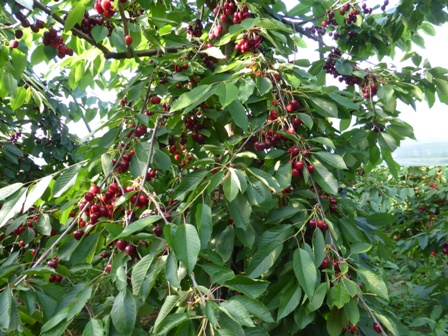
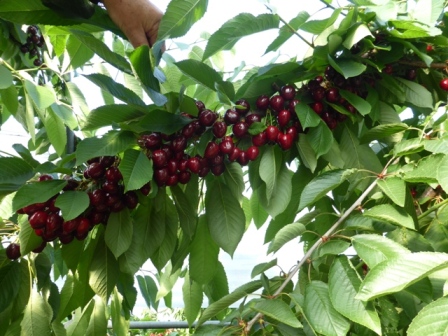
Cherry size can be dramatically increased by allowing a few more days on the tree; the growing medium (under tunnels) has changed the potential for cherries compared to 20 years ago when most would have been growing without protection. Will Riccini said he would prefer to wait until next week to maximise size, but the marketing agency is seeking fruit for Supermarket customers; but as Will reflected - 'the price this week' will be better than next week!
Below: Kordia 'nearly' ready for picking and equipment 'lined up' and 'ready to go'
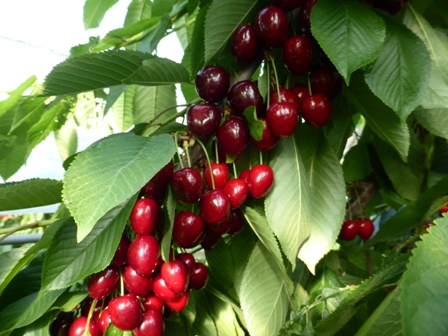
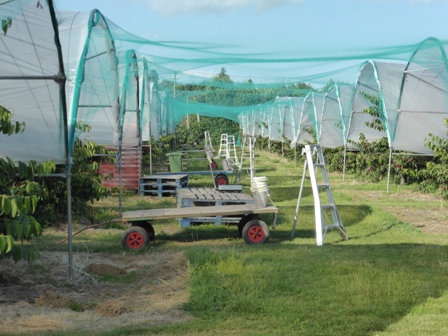
The evening was scheduled as a Stone Fruit Farm Walk, but with apples and pears also grown at Bekesbourne it was an opportunity to view the orchards as well.
Will Riccini told the EKFS members the Gala yield was 2,200 bins in 2014 and they anticipate 2,500 this season; likewise Braeburn produced 1,100 bins in 2014 with 2,500 expected by 2017. Cox is now a small part of the top fruit business with circa 250 bins and Conference pears around 500 bins.
Below: Gala orchard
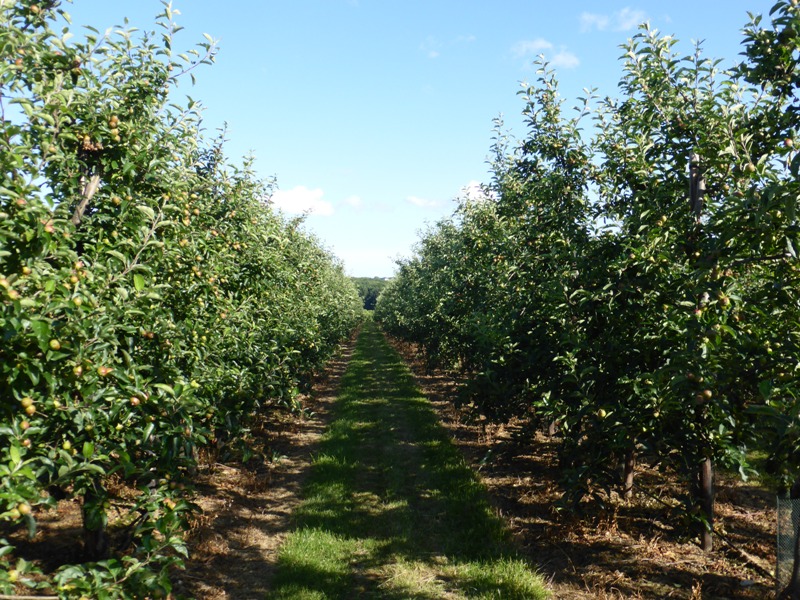
Braeburn has the capability to 'out-yield' Gala; fruit size as well as fruit numbers on a tree is a key component in the yield 'equation' - Will Riccini said the 2014 yield of 81 tonnes per hectare, this equates to circa 200 apples per tree. Thinning is important and Will said they start 'hand thinning' early on the Gala trees, simply because of the need to 'get started' and this results in the early thinning cost = 75p per tree but reduces to 20-30p per tree on the last trees thinned. The objective; to thin to 2 apples per bunch, with the option to reduce further with a quality thin later in the season.
Below: Gala trees and Breaburn trees
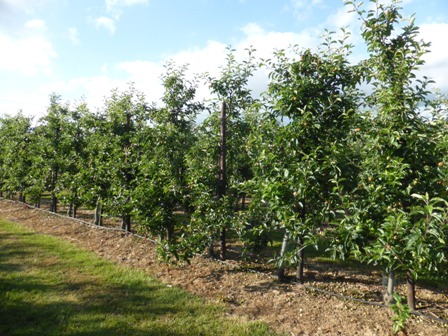
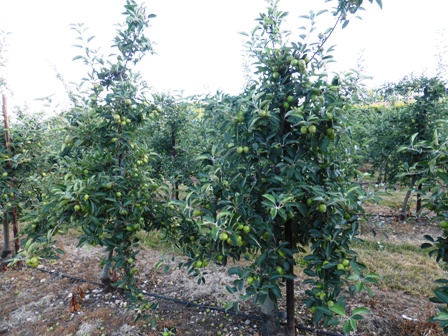
Returning to the theme of 'twisting' Will Riccini said they have tried it on one block of Gala and left the opposite block 'untwisted' again the result is not easily discernible.
Below: Pictured; Tops of Gala trees - and Pears at Bekesbourne
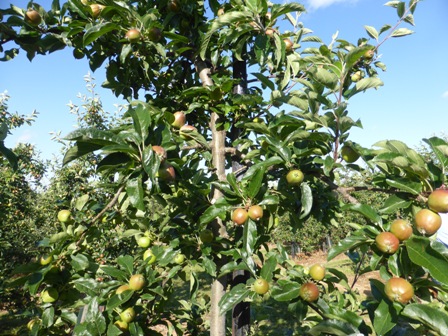
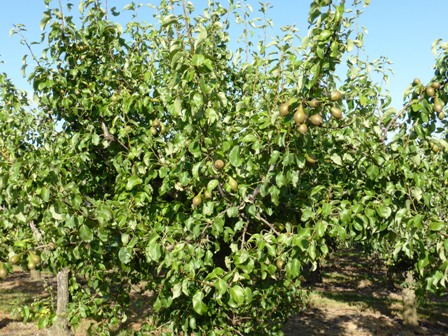
2015 - looking ahead!
At this stage of the season projections for the 2015 crop are being made by the industry body; 'English Apples & Pears' - the prognosis is for a crop similar to last year; size at this stage is 'spot on' for the optimum required at harvest. Gala (Mr.Reliable) is carrying a good crop, which with the increase from younger trees coming into heavier cropping promises to exceed previous years.
Cox (once the star of English apples) is expected to equal last year's production, but is variable across the regions. Skin finish looks good.
Egremont Russet (popular with the 'more mature' consumers - like ME) looks to be similar to past years; fruit below 65mm (4 to the lb) in size is difficult to sell. Thinning is vital for a worthwhile financial return.
Braeburn looks to be a good crop. Cameo similar. Red Windsor 'likewise' - early varieties Discovery and Worcester reducing in acreage, but similar crop potential to 2014.
Conference pears; questionable yield potential with some similar to 2014 but others forecast to be less than 50% of last year. Comice (very good in 2014) well down this year.
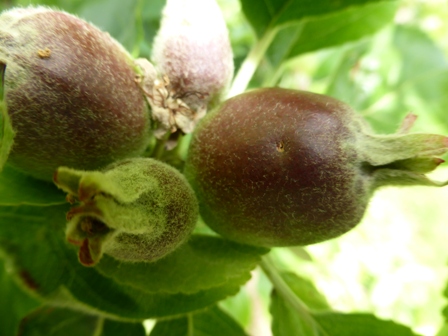 Bramley: while crops per acre/hectare are similar to last year, after a very difficult year (2014/15) when sales were poor, particularly for the processing industry which is the 'support structure' for culinary apples, many orchards have been grubbed. Indications are that 'Sods Law' may apply again with shorter crops forecast for Ireland (which is the key driver for Bramley processing) = time will tell!
Bramley: while crops per acre/hectare are similar to last year, after a very difficult year (2014/15) when sales were poor, particularly for the processing industry which is the 'support structure' for culinary apples, many orchards have been grubbed. Indications are that 'Sods Law' may apply again with shorter crops forecast for Ireland (which is the key driver for Bramley processing) = time will tell!
Hail of course has influenced the quality from 'farm to farm' and some growers have suffered badly; the majority will benefit from good crops (especially Gala) with the potential to thin (albeit expensively) the hail damaged fruit and still have a good marketable crop.
Many thanks to my good friend Roger Worraker who supplied much of the crop forecast information!
After our tour of Bekesbourne Farm we were treated to a 'Burger & a Beer' in David Riccini's garden; most enjoyable and before I left an opportunity to take a picture of a group of Under 40's with Charlie Dunn - Chairman of Under 40's 2017 Conference. Among the group, Malcolm Withnall - one of the founding fathers responsible for the first U40 Conference in 1967. The next U40 will be the 50th Conference!
Below: Centre kneeling - Charlie Dunn and back row 2nd from the right - Malcolm Withnall
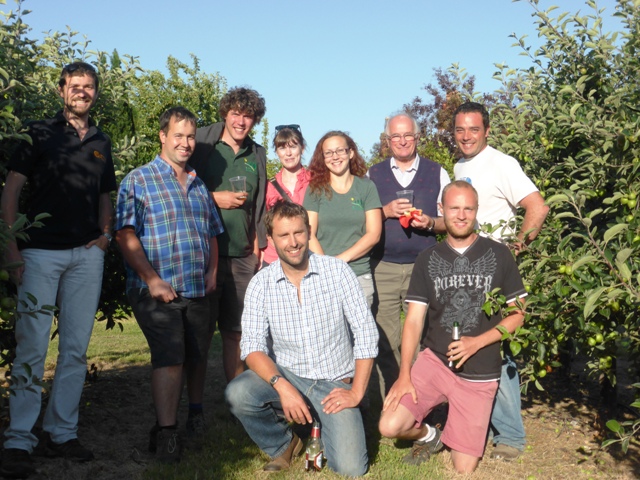
That is all for this week........next week The English Apple Man will be visiting orchards in East Anglia....
Take care
The English Apple Man